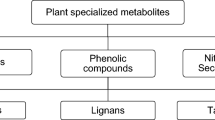Abstract
Fruits ofPastinaca sativa (Apiaceae), the edible parsnip, contain six different furanocoumarins that are differentially capable of ultraviolet-mediated cross-linkage of DNA and inhibition of DNA transcription. Individually, none of the other furanocoumarins present in parsnip seeds is as toxic as the photosensitizer xanthotoxin. Nevertheless, the natural mixture of compounds is toxicologically more effective againstHeliothis zea (Lepidoptera: Noctuidae), both in the presence and absence of UV light, than is an equimolar amount of xanthotoxin. The difference in toxicity diminishes with increasing light levels. Thus, a series of structurally related natural products can display toxicity lacking in individual compounds and may represent an adaptive compromise to varying environmental conditions.
Similar content being viewed by others
References
Ashwood-Smith, M.J., Poulton, G.A., Barker, M., andMildenberger, M. 1980. 5-Methoxypsoralen, an ingredient in several suntan preparations, has lethal, mutagenic and clastogenic properties.Nature 285:407–410.
Berenbaum, M. 1978. Toxicity of a furanocoumarin to armyworms: A case of biosynthetic escape from insect herbivores.Science 201:532–534.
Berenbaum, M. 1985. Brementown revisited: Interactions among allelochemicals in plants.Recent Adv. Phytochem. 19:139–169.
Berenbaum, M.R., Zangerl, A.R., andNitao, J.K. 1984. Furanocoumarins in seeds of wild and cultivated parsnip.Phytochemistry 23:1809–1810.
Caffieri, S., Daga, A., Vedaldi, D., andDall'acqua, F. 1988. Photoaddition of angelicin to linolenic acid methylester.J. Photochem. Photobiol, B. Biol. 2:515–521.
Chew, F.S., andRodman, J.E. 1979. Plant resources for chemical defense, pp. 271–308,in G.A. Rosenthal and D.H. Janzen (eds.). Herbivores: Their Interaction with Secondary Plant Metabolites. Academic Press, New York.
Grossweiner, L.I. 1984. Mechanisms of photosensitization by furocoumarins, pp. 47–54,in Photobiologic, Toxicologic and Pharmacologic Aspects of Psoralens. National Cancer Institute Monograph 66. U.S. Department of Health and Human Services, Bethesda, Maryland.
Ivie, G.W. 1978. Linear furocoumarins (Psoralens) from the seed of TexasAmmi majus L (Bishop's weed).J. Agric. Food Chem. 26:1394–1403.
Ivie, G.W., Holt, D.L., Ivey, M.C. 1981. Natural toxicants in human foods: Psoralens in raw and cooked parsnip root.Science 213:909–910.
Kogan, J., Sell, D.K., Stinner, R.E., Bradley, J.R., andKogan, M. 1978. V. A Bibliography ofHeliothis zea (Boddie) andH. virescens (F.) (Lepidoptera: Noctuidae). INTSOY series number 17. International Agricultural Publications. Urbana, Illinois.
McKey, D. 1979. The distribution of secondary compounds within plants, pp. 56–133,in G.A. Rosenthal and D.H. Janzen (eds.). Herbivores, Their Interaction with Secondary Plant Metabolites. Academic Press, New York.
Murray, R.D.H., Mendez, J., andBrown, S.A. 1982. The Natural Coumarins. John Wiley & Sons, Chichester, England.
Musajo, L., Rodighiero, G., Caporale, G., Dall'acqua, F., Marciana, S., Bordin, F., Baccichetti, F., andBevilacqua, R. 1974. Photoreactions between skin-photosensitizing furocoumarins and nucleic acids, pp. 369–387,in T.B. Fitzpatrick, M.A. Pathak, L.C. Harber, M. Seiji, and A. Kukita (eds.). Sunlight and Man: Normal and Abnormal Photobiologic Reactions. University of Tokyo Press, Tokyo.
Nitao, J.K., andZangerl, A.R. 1987. Floral development and chemical defense allocation in wild parsnip (Pastinaca sativa).Ecology 68:521–529.
Nitao, J.K., andBerenbaum, M.R. 1988. Laboratory rearing of the parsnip webworm,Depressaria pastinacella (Lepidoptera:Oecophoridea).Ann. Entomol. Soc. Am. 81:485–487.
Pathak, M.A., andFitzpatrick, T.B. 1959. Relationship of molecular configuration to the activity of furocoumarins which increase the cutaneous responses following long wave ultraviolet radiation.J. Invest. Dermatol. 32:255–264.
Yajima, T., Kato, N., andMunakatta, R. 1977. Isolation of insect antifeeding principles inOrixa japonica.Thunb. Ag. Biol. Chem. 41:1263–1268.
Zangerl, A.R., andBerenbaum, M.R. 1987. Furanocoumarins in wild parsnip: Effects of photosynthetically active radiation, ultraviolet light, and nutrients.Ecology 68:516–520.
Zangerl, A.R., andBerenbaum, M.R. 1990. Furanocoumarin induction in wild parsnip: Genetics and populational variation.Ecology. 71:1933–1940.
Author information
Authors and Affiliations
Rights and permissions
About this article
Cite this article
Berenbaum, M.R., Nitao, J.K. & Zangerl, A.R. Adaptive significance of furanocoumarin diversity inPastinaca sativa (Apiaceae). Journal of Chemical Ecology 17, 207–215 (1991). https://doi.org/10.1007/BF00994434
Received:
Accepted:
Issue Date:
DOI: https://doi.org/10.1007/BF00994434




